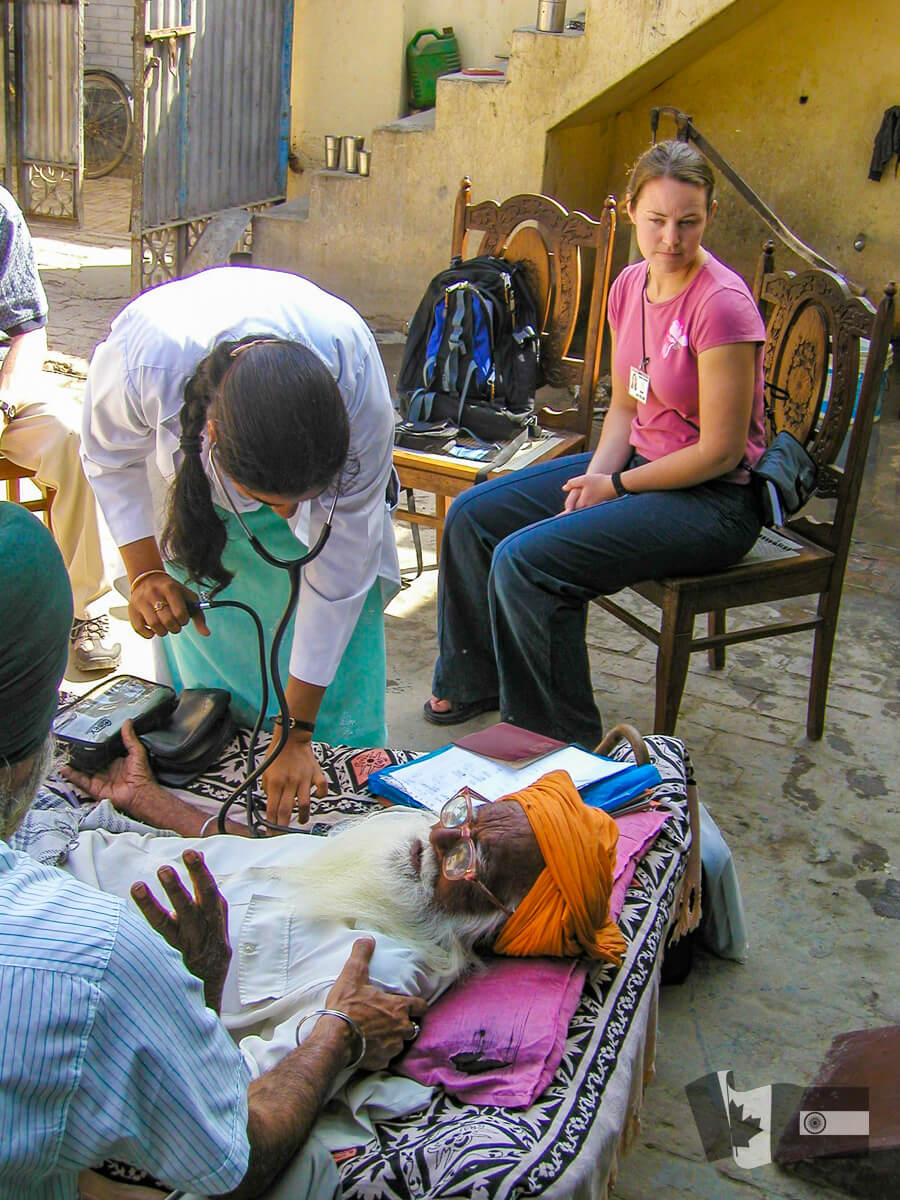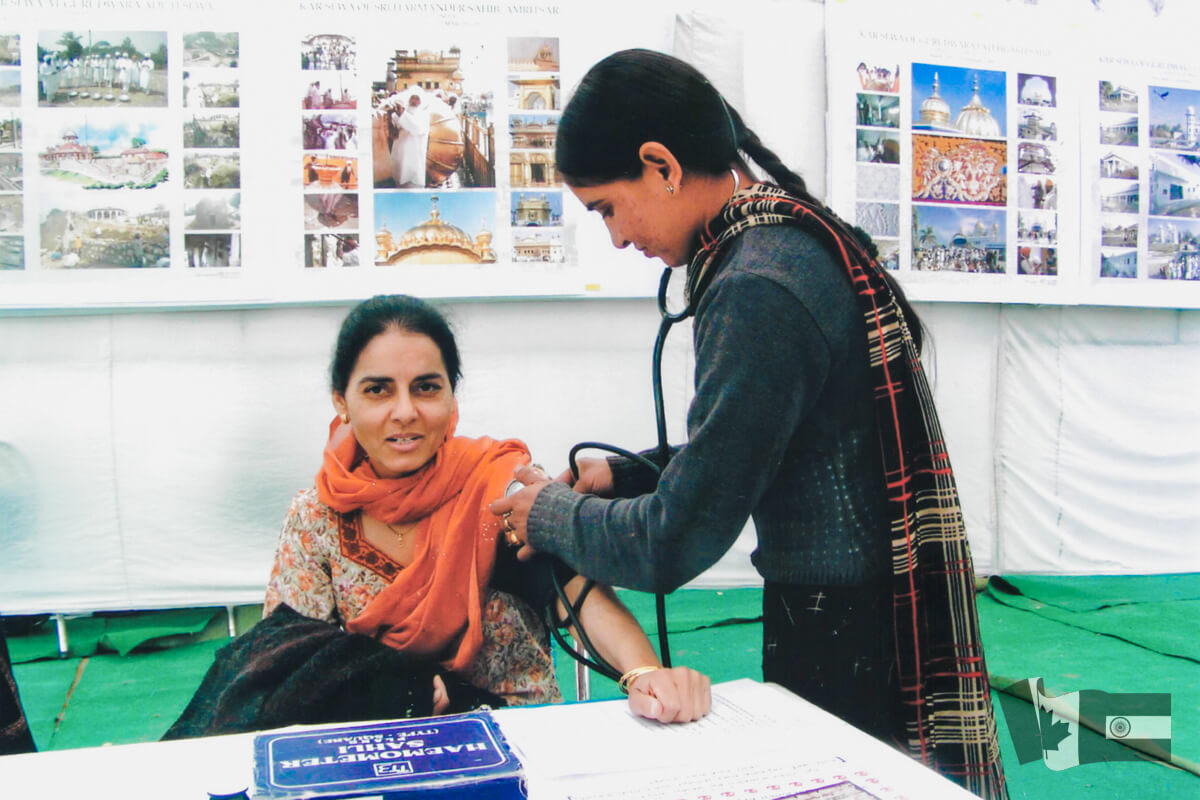Bringing healthcare to underserved populations in rural India
Between 2001 to 2005, CIES raised over $400,000, largely thanks to the Canadian International Development Agency (CIDA) for the Building Capacity for Primary Health Care in Rural Punjab project. The project aimed to improve access to preventive health care in the sixty rural communities surrounding Dhahan Kaleran.
This project utilized the skillset of nursing faculty and nurses-in-training from both the University of British Columbia (UBC) School of Nursing and the Guru Nanak College of Nursing (GN College).


The UBC School of Nursing’s Guru Nanak Advisory Committee provided expert advice for overall project planning, proposal development, monitoring, and evaluation. The Guru Nanak Mission Medical and Educational Trust (GN Trust) provided transportation, office space, lodging for the team members and medical support from doctors.
Understanding the situation in rural Punjab at the time of the project
When we say “rural” in relation to this project, we should note that these are ‘working-class’ villages where mostly farmers and labourers live. While only about 9.8% of these households were considered “low income,” keep in mind that living standards in these regions are a far cry from what we are accustomed to in Canada.
Below is a description of what was found at the time that the project took place (and much of this may very well still be true today):


Literacy rates in the villages were at approximately 70%.
Both concrete and thatched mud houses existed.
Water access was mostly through handpumps (88.2% didn’t have access to wells or piped water). Sometimes, these hand pumps were near polluted, open drainage ponds where sewage ended up. Latrines with septic tanks leading to community drains were common.
Roughly half of all households were defecating openly, which contributed to diarrhea, Typhoid, Tuberculosis and respiratory diseases.
Garbage was disposed of anywhere and everywhere. Mosquitos and houseflies were abundant, due to poor sanitation. These only help diseases spread further.
Apart from communicable disease, hypertension, arthritis, diabetes, eye disease, anxiety disorder and drug addiction rates were high (including for alcohol and cannabis). Surprisingly, tobacco usage was low in these areas.
These villages were also sometimes hard to access, which made health care delivery extra difficult.

Activities that took place to improve the capacity for primary health care in rural Punjab

CIES carried out the project in two phases: a focused planning phase in the first year, followed by program implementation over a three-year period.
Faculty and at least 163 nursing students from both UBC and GN College visited rural villages on health-related missions. Volunteers were also recruited to participate in activities.
Gaining trust and spreading awareness of the service offerings to villagers
To gain the trust of locals, village councils (panchayats) were asked to introduce the project at religious and public gatherings. In addition, pamphlets, press releases and cooperation with other NGOs helped to spread the message.

Healthcare service delivery

The medical and volunteer team attended to the varying healthcare needs of locals. This included medicine distribution and health checkups in homes (especially for pregnant women). “Health camps” were also held in schools and other locations.
Health education presentations
The team also performed educational activities, such as health talks and seminars. These exhibitions employed role play, drama and artistic posters to appeal to the locals.
Educational presentations were on topics including:
- Family planning
- The importance of breastfeeding and how to overcome feeding problems.
- Environmental sanitation such as with water purification and the avoidance of burning fuel inside a home (which can lead to asthma and respiratory problems)
- Prevention and control of diseases such as cholera, scabies, glaucoma, cataracts, chicken pox, tuberculosis, malaria, hepatitis, tetanus, diphtheria, leprosy, AIDS, etc.
- Immunization
- Personal hygiene
- How to care for elderly at home
- Gender equality
Substance abuse counselling was offered to those struggling with addictions , as well as to youth in schools, as a preventative measure.
Health resource information was created in Punjabi.


Outcomes of the project:

60 villages within a 25km radius of Dhahan Kaleran received healthcare access, thanks to the team of nurses, doctors, counselors, nursing students and volunteers recruited for the project.
Healthcare advice and help was given to over 50,500 locals comprising 9,688 households. This increased community health awareness, changed household health practices, and achieved active participation by women.
171 volunteers, especially women, were trained to be “health promoters” in the region.
New alliances were fostered among non-governmental organizations in the area, particularly among groups working in reproductive health and gender issues
Nursing student skills development
Students gained an understanding of healthcare and nursing contexts in rural communities in Punjab. They developed skills in communication, as well as delivery of healthcare services in ‘real life.’ Even more crucially, they learned how to overcome cultural barriers, and to dispel myths of tradition that can affect the health of populations.

Population health survey

In addition to the delivery of healthcare services and education, a team of 134 students worked on an instrumental survey to gather data about the households in these villages. These surveys provided the foundation for being able to understand the population’s healthcare needs. It also allowed for future planning and outreach activities.
After the project was completed, a further (mandatory) review of data was compiled by the Institute for Development and Communication. This allowed for further evaluation and future healthcare planning in the region.
Amounts raised April 1, 2001 to March 31, 2002:
CIDA: $47,150
CIES: $23,575
GN Trust: In-kind – lodging, transportation, operations, admin, etc.
Amounts raised April 1, 2002 – March 31, 2005:
CIDA: $220,000
CIES: $110,00
GN Trust: In-kind – lodging, transportation, operations, admin, etc.